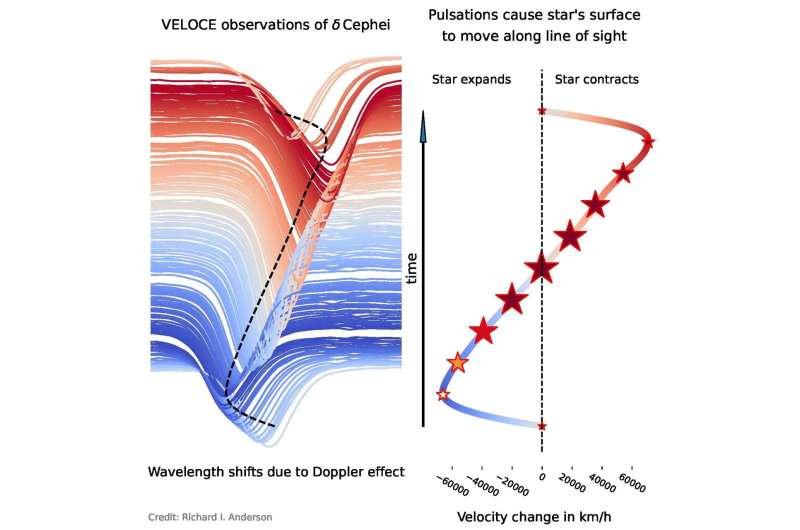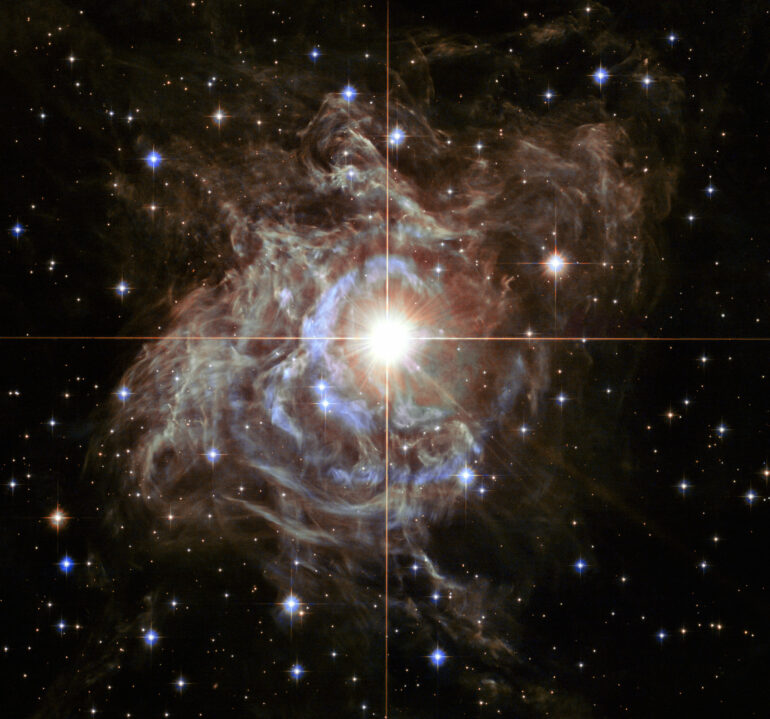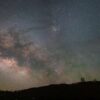“Classical Cepheids” are a type of pulsating star that rhythmically brighten and dim over time. These pulsations help astronomers measure vast distances across space, which makes Cepheids crucial “standard candles” that help us understand the size and scale of our universe.
Despite their importance, studying Cepheids is challenging. Their pulsations and potential interactions with companion stars create complex patterns that are difficult to measure accurately. Different instruments and methods used over the years have led to inconsistent data, complicating our understanding of these stars.
“Tracing Cepheid pulsations with high-definition velocimetry gives us insights into the structure of these stars and how they evolve,” says Richard I. Anderson, an astrophysicist at EPFL. “In particular, measurements of the speed at which the stars expand and contract along the line of sight—so-called radial velocities—provide a crucial counterpart to precise brightness measurements from space. However, there has been an urgent need for high-quality radial velocities because they are expensive to collect and because few instruments are capable of collecting them.”
The VELOCE Project
Anderson has now led a team of scientists to do exactly that with the VELOcities of CEpheids (VELOCE) project, a large collaboration that over 12 years has collected more than 18,000 high-precision measurements of 258 Cepheid radial velocities using advanced spectrographs between 2010 and 2022. Their research is published in the journal Astronomy & Astrophysics.
“This dataset will serve as an anchor to link Cepheid observations from different telescopes across time and hopefully inspire further study by the community,” says Anderson.
VELOCE is the fruit of a collaboration among EPFL, the University of Geneva, and KU Leuven. It is based on observations from the Swiss Euler telescope in Chile and the Flemish Mercator telescope on La Palma. Anderson began the VELOCE project during his Ph.D. at the University of Geneva, continued it as a postdoc in the US and Germany, and has now completed it at EPFL. Anderson’s Ph.D. student, Giordano Viviani, was instrumental in making the VELOCE data release possible.
Unraveling Cepheid mysteries with cutting-edge precision
“The wonderful precision and long-term stability of the measurements have enabled interesting new insights into how Cepheids pulsate,” says Viviani. “The pulsations lead to changes in the line-of-sight velocity of up to 70 km/s, or about 250,000 km/h. We have measured these variations with a typical precision of 130 km/h (37 m/s), and in some cases as good as 7 km/h (2 m/s), which is roughly the speed of a fast walking human.”
To get such precise measurements, the VELOCE researchers used two high-resolution spectrographs, which separate and measure wavelengths in electromagnetic radiation: HERMES in the northern hemisphere and CORALIE in the southern hemisphere. Outside of VELOCE, CORALIE is famous for finding exoplanets and HERMES is a workhorse of stellar astrophysics.
The two spectrographs detected tiny shifts in the Cepheids’ light, indicating their movements. The researchers used advanced techniques to ensure their measurements were stable and accurate, correcting for any instrumental drifts and atmospheric changes.
“We measure radial velocities using the Doppler effect,” explains Anderson. “That’s the same effect that the police use to measure your speed, and also the effect you know from the change in tone when an ambulance approaches or recedes from you.”

VELOCE observations trace the expansion and contraction of Cepheid stars with unprecedented precision. On the left: observed spectra of the Cepheid archetype Delta Cephei as they change in wavelength due to the pulsations. On the right: the radial velocity curve measured by VELOCE, with the star’s variable size shown (not to scale) using star-shaped symbols. © R.I. Anderson (EPFL)
The strange dance of Cepheids
The VELOCE project uncovered several fascinating details about Cepheid stars. For example, VELOCE data provide the most detailed look yet at the Hertzsprung progression—a pattern in the stars’ pulsations—showing double-peaked bumps that were not previously known and will provide clues to better understanding the structure of Cepheids when compared to theoretical models of pulsating stars.
The team found that several Cepheids exhibit complex, modulated variability in their movements. This means that the stars’ radial velocities change in ways that cannot be explained by simple, regular pulsation patterns. In other words, while we would expect Cepheids to pulsate with a predictable rhythm, the VELOCE data reveal additional, unexpected variations in these movements.
These variations are not consistent with theoretical pulsation models traditionally used to describe Cepheids. “This suggests that there are more intricate processes occurring within these stars, such as interactions between different layers of the star, or additional (non-radial) pulsation signals that may present an opportunity to determine the structure of Cepheid stars by asteroseismology,” says Anderson’s postdoc Henryka Netzel. First detections of such signals based on VELOCE are reported in a companion paper (Netzel et al., in press).
Binary systems
The study also identified 77 Cepheid stars that are part of binary systems (two stars orbiting each other) and found 14 more candidates. A companion paper led by Anderson’s former postdoc, Shreeya Shetye, describes these systems in detail, adding to our understanding of how these stars evolve and interact with each other.
“We see that about one in three Cepheids has an unseen companion whose presence we can determine by the Doppler effect,” says Shetye.
“Understanding the nature and physics of Cepheids is important because they tell us about how stars evolve in general, and because we rely on them for determining distances and the expansion rate of the universe,” says Anderson. “Additionally, VELOCE provides the best available cross-checks for similar but less precise measurements from the ESA mission Gaia, which will eventually conduct the largest survey of Cepheid radial velocity measurements.”
More information:
Richard I. Anderson et al, VELOcities of CEpheids (VELOCE). I. High-precision radial velocities of Cepheids, Astronomy & Astrophysics (2024). DOI: 10.1051/0004-6361/202348400. www.aanda.org/10.1051/0004-6361/202348400
Provided by
Ecole Polytechnique Federale de Lausanne
Citation:
High-precision measurements challenge our understanding of Cepheids (2024, June 14)



